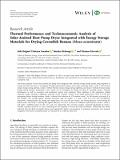Thermal Performance and Technoeconomic Analysis of Solar-Assisted Heat Pump Dryer Integrated with Energy Storage Materials for Drying Cavendish Banana (Musa acuminata)

View/
Date
2024-02-02Author
Loemba, Aldé Belgard
Kichonge, Baraka
Kivevele, Thomas
Metadata
Show full item recordAbstract
This study examines a novel solar-assisted heat pump dryer integrated with a thermal energy storage system using soapstone as
storage material. The dryer is investigated through experimental analysis across three operating modes: mode 1 with thermal
energy storage during daytime, mode 2 without thermal energy storage during nighttime, and mode 3 without thermal energy
storage during daytime. Experiments were carried out to investigate the drying of 500 g of Cavendish banana. Thermal
performance, as well as economic, and nutritional content were examined. Three replicates of the experiment yielded
consistent results, showing a significant reduction in the moisture content of the initial sample from 74.4% to 9.6% after
undergoing distinct drying durations. Mode 1 achieved this reduction in 270 minutes, mode 2 in 390 minutes, and mode 3 in
360 minutes. The average specific moisture extraction rates for modes 1, 2, and 3 were 0.13, 0.11, and 0.12 kg/kWh,
respectively. Simultaneously, the drying rate ranged from 0.16 to 0.24% per minute. The drying efficiency varied among the
tested modes, with mode 1 achieving the highest efficiency at 23.23%. In terms of coefficient of performance, mode 1, mode 2,
and mode 3 exhibited values of 3.69, 2.57, and 2.54, respectively. The economic analysis conducted specifically for mode 1
revealed a payback period of 1.5 years, indicating the time required to recover the initial investment. Additionally, the results
indicated that the dried Cavendish banana had significantly higher concentrations of proximate parameters and minerals
compared to the fresh Cavendish banana, as evidenced by a p value less than 0.05.
